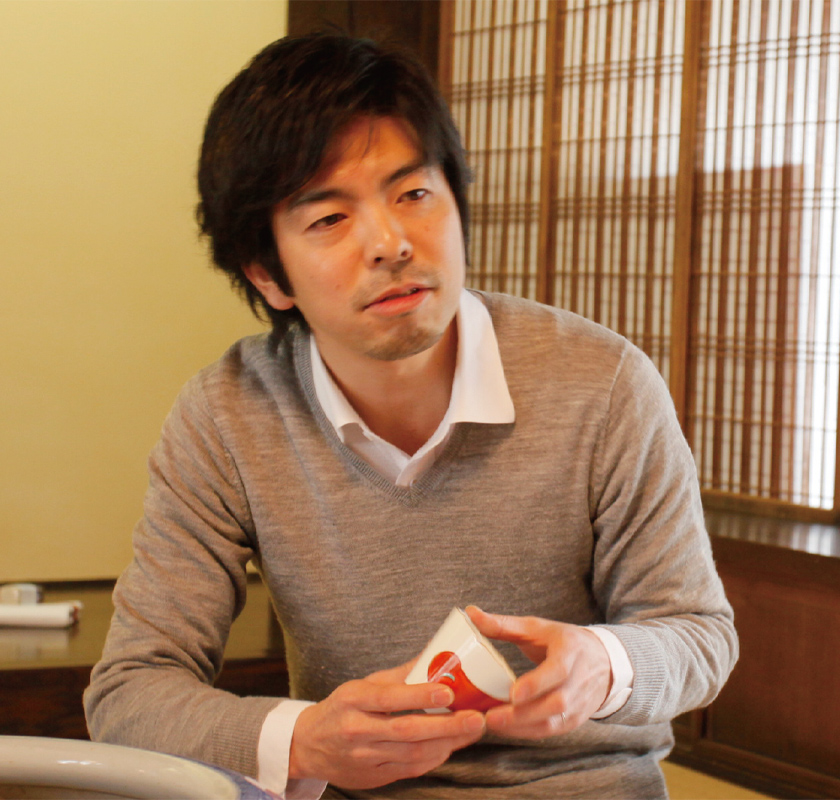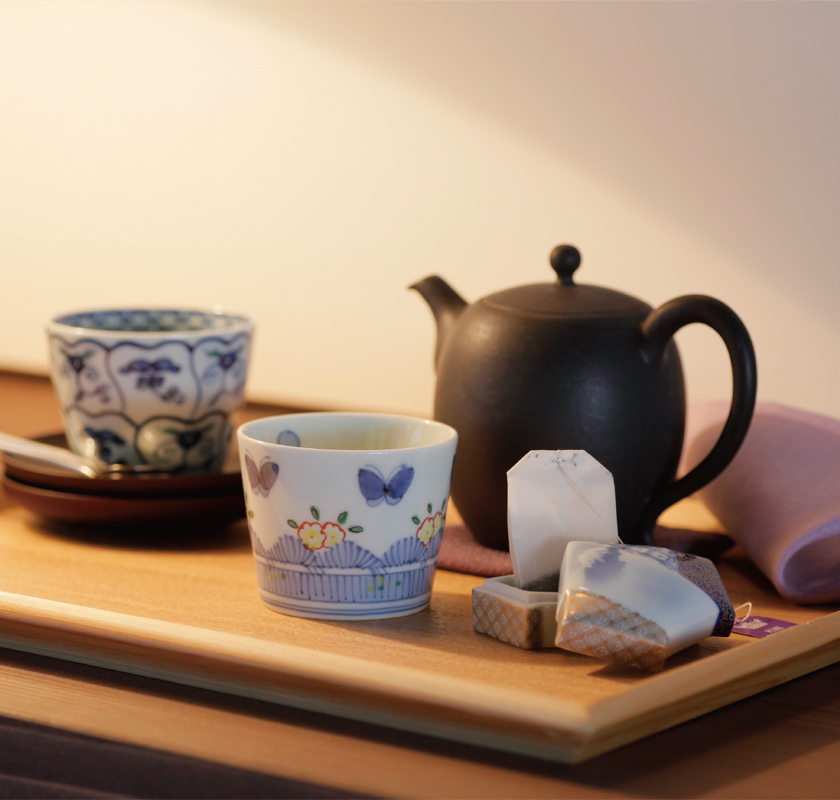Sobachoko cups could be fairly characterised as ceramic objects that give shape to the Japanese people, hard workers with characteristically small builds. That’s because you won’t find anything of similar proportion, shape, or use overseas.
Originally made to hold cuisine (when they were known as mukozuke cups), sobachoko began to play a useful role–a use which they continue to fulfil today–as dishes for holding dipping sauce as noodle cuisine became popular. In today’s era of mixing and matching Japanese and foreign influences, sobachoko are attracting a growing number of enthusiasts and collectors as an all-capable dish.
For this article, we invited four people involved in Arita’s ceramic community to bring a number of favourite sobachoko and participate in a small, intimate discussion. The conversation flowed freely, starting with the history of sobachoko and moving on to topics including current and historical uses of the cups, points of pride with regard to Arita sobachoko, and the secrets of the form’s enduring popularity.
Suzuta Yukio (59), director of The Kyushu Ceramic Museum, brought a number of exceptional sobachoko chosen from the museum’s Kashima Nabeshima Family Collection and Mr. and Mrs. Shibata Collection. We asked him to get the ball rolling by explaining the characteristics of those fine works.
『そば猪口』は、働き者で小柄な日本人をかたちにしたやきものといってもいい。なぜなら、そのサイズ感といい、形状といい、用途といい、外国では決して見られない存在だからだ。
もともとは料理を入れる〈向付〉だったものが、麺類の普及に伴い、つけ汁用の器として今日まで重宝されてきた。一方、和洋折衷の昨今の食卓では、オールマイティな器として愛用者やコレクターが増えている。
そこで今回は、有田でやきものに関わる4人のそば猪口好きにご自慢の〈そば猪口〉を持って集まっていただき、車座トークを開催。そば猪口の歴史に始まり、使い方の今昔、有田のそば猪口自慢、永遠の人気のヒミツなどを自由に語っていただいた。
佐賀県立九州陶磁文化館の館長・鈴田由紀夫さん(59)は、この日のために館所蔵の〈鹿島鍋島家コレクション〉や〈柴田夫妻コレクション〉の選りすぐりのそば猪口を持ってきてくださった。それら名品の解説を交えながら、座談会の口火を切っていただいた。
-

Suzuta Yukio, Director, The Kyushu Ceramic Museum
九州陶磁文化館館長の鈴田由紀夫さん -

Sobachoko cups from the collection of The Kyushu Ceramic Museum
九州陶磁文化館所蔵のそば猪口コレクション
Sobachoko cups emerged around 1700.
In terms of shape, sobachoko are defined by a flat bottom and straight sides. Initially, they were quite small, with a diameter of 7 or 8 centimetres. Over time, their shape changed gradually from a trapezoidal form to a cylindrical form, and they became somewhat larger.
The 18th century brought the popularisation and mass production of porcelain products, along with the emergence of simplified pattens, printing techniques such as konnayaku inban stamps, and stencilling. There was a blossoming of elements such as designs executed on the inner bottom of the cups, spurring people to collect them while enjoying viewing a variety of designs. An example of such designs is the plum motif known as a “five petal flower,” which boomed in popularity during the Edo period (1603-1868).
Starting during the middle of the 18th century, we see donut-shaped bottoms known as janome ōgata kōdai. The feature, which was created by a firing method that involved placing works in contact with kiln tools during firing to lift the bottom, allowed the part of the bottom that comes into contact with tables and trays, known as the tatamitsuki, to be glazed. As a result, cups could be placed on delicate surfaces such as lacquer without causing damage.
In a word, sobachoko exhibit a certain unity, as if different designs are being applied to the same shape. As a result, they are now, as they were in the past, collectors’ items with broad appeal. One aspect of their appeal is that as your collection grows, you can simply stack them together, making them convenient to store.
“If I could take just one item with me to a deserted island,” Suzuta said, “it would be a sobachoko, which I could also use as a measuring cup.”
The participants burst into smiles at Suzuta’s witty comment.
そば猪口のはじまりは1700年前後から
形の定義としては底が平らで、側面が直線的に立ち上がっているもの。最初はとても小さく口径が7〜8cmほどで、形は台形から徐々に筒型へと変化し、やや大型になっていった。
18世紀に入ると、磁器製品が大衆化して量産されるようになり、簡略化した文様やコンニャク印判、型紙摺りといった印刷技術が登場。内底にも柄が描かれるなど、さまざまな模様を見て、集めて楽しむコレクション的要素が芽生えたようだ。中でも内底に描かれた梅の絵柄は〈五弁花〉と呼ばれ、江戸時代に大流行した。
18世紀中期以降のものに〈蛇の目凹形高台〉と呼ばれる、底がドーナツのような形の高台がある。これは窯道具を当てて浮かせて焼くという焼成法によるものだが、こうすることにより〈畳付〉とよばれる底が机や盆に触れる部位に釉薬がかかり、漆盆のようなデリケートなものの上に置いても傷がつきにくいというメリットがあった。
そば猪口をひと言で表すと、同形で絵替わりの一体感がある。それゆえ、昔も今も幅広い層に人気のコレクターズアイテム。たとえ収集数が増えようとも、重ねてしまえる収納の便利さも大きなポイントなのだ。
「無人島にひとつだけ持っていくものとしたら、わたしは計量カップにもなるそば猪口ですね」。
鈴田館長の奇想天外なユーモアに、どっと笑いが起こった。
-

Sobachoko cups from the collection of The Kyushu Ceramic Museum
九州陶磁文化館所蔵のそば猪口コレクション
The Japanese aesthetic as seen in sobachoko cups
Shinohara Yasutoshi (60) of Keizan Kiln realised the potential of the contemporary sobachoko boom early on. Upon visiting a wholesaler, he learned that the company was receiving a constant series of orders for sobachoko. He wasted no time in using a sobachoko dictionary to choose 100 of his favourite designs and painting them onto sobachoko, which he then featured in a show entitled “100 Selected Sobachoko Cups” at a hotel in Tokyo in 1983. That show sparked a boom in popularity that has continued unabated to this day. That popularity, which has been as stable over time as the style’s shape, even resists the effects of economic downturns.
As Shinohara puts it, “I was selling 3,000 cups a month at the time. These days it’s more like 4,000 a year, but sobachoko remain a product that sells reliably. There’s only one shape, which we call ‘drum-shaped,’ while it’s variety of design that determines each cup’s appeal.”
Contemporary sobachoko designs feature animals, flowers, and geometric patterns, some of which draw on the extensive designs seen in Ko-Imari. “Women like circle patterns,” notes Imamura Maki (37) of Imamura Porcelain Machiya , who went on to compare sobachoko to women's fashions.
“Ceramic wares don’t usually depict insects, but one can find sobachoko with patterns featuring insects like simplified butterflies and bees. It seems to me that such works exhibit the same sort of intentionally different look that you see in combinations of clothing. Like a skull serving as an accent in an otherwise cute outfit, I suspect adding a sobachoko whose design will take viewers aback to everyday tableware can broaden our enjoyment of ceramics.”
そば猪口に見える、日本人の美意識
現代のそば猪口ブームにいち早く目をつけたのが、『渓山窯』の篠原康年さん(60)。訪ねた問屋さんの店先で、次々とそば猪口のオーダーが入ることを知った。すぐさまそば猪口事典を手がかりに気に入った絵柄100種類を選んで絵付けし、昭和58年には東京のホテルで〈そば猪口100選展〉を開催。それでブームに火がつき、現在に至っているという。不景気な世の中にも強い、まさに形そのものも安定感のある人気ぶりだ。
篠原さんいわく、「当時は月3000個は売れてましたよ。今じゃ年間4000個くらいにはなりましたが、確実に売れる商品ですね。うちでは〈太鼓型〉と呼んでいますが、そば猪口の形は1パターンでよくて、絵柄のバラエティの豊富さが勝負なんです」。
古伊万里の豊富な絵柄をヒントに生まれた、動物・花・幾何学文様が描かれた現代のそば猪口。「女性に人気なのは丸紋ですね」と語るのは、紅一点の『陶悦窯 町屋』の今村麻希さん。(37)彼女は女性のファッションにたとえてこう言う。
「通常、器の模様に昆虫はあまり用いられませんが、そば猪口にはチョウやハチなどのゆるい昆虫柄を見かけます。これってお洋服のコーディネイトと同じで、わざとはずす感覚に似ている気がするんです。可愛い中にドクロのワンポイントを持ってくるみたいに、ちょっと毒気のあるそば猪口を家庭の器に加えてみると、やきものの楽しみ方の幅が広がるんじゃないかと思うんです」。
-

Shinohara Yasutoshi of the Keizan Kiln
渓山窯の篠原康年さん -

Imamura Maki of Imamura Porcelain Machiya
今村製陶 町屋の今村麻希さん
A certain looseness of style that evokes a sense of the craftsman’s playfulness is perfect for items that see everyday use. Additionally, incorporating classical things into modern life in a way that suits today’s lifestyles can create unexpected uses and living spaces. Recently, a lot of people use sobachoko as tea cups or coffee cups, and some customers even order saucers to match the cups’ designs. Some people use them for chilled sake, and one soba chef lets customers choose from a large selection of sobachoko so that they can enjoy their meal with a cup they like.
“With people who like Ko-Imari, you know at the beginning how they’re going to approach the world of ceramics,” explained Matsumoto Koji (37) of Kihara, a trading company that specialises in local ceramic products. “But for everyone else, instead of actual styles of Arita ware, such as the Kakiemon style, I show them designs that arrange those characteristics in a modern way. For me, sobachoko are like free-style T-shirts.”
The group expressed its approval of this apt comparison. sobachoko cups, which might appear to be glasses or general-use cups if you don’t know what they’re designed for, are to Japanese a traditional, all-capable vessel of tableware that fits snugly in the palm of one’s hand.
職人の遊び心を感じさせるゆるさが、普段使いにはちょうどいい。また、古典的なものを今の暮らしに取り入れ、生活シーンに合ったスタイリングをすることで、思いがけない用途や生活空間が生まれる。近頃では湯のみやコーヒーカップとして使う人も多く、中には柄に合わせた受け皿を別注されるお客さんもいらっしゃるとか。冷酒を楽しむ方や、中には蕎麦屋さんのアイデアで、お客さんに気に入ったそば猪口で食べてもらいたいと、店内に数々のそば猪口を並べているところもあるそうだ。
「古伊万里が好きな方は最初から器の世界への入口は決まっているんでしょうが、そうでない方にはリアルな柿右衛門様式ではなく、その特徴をモダンデザインにアレンジして見せることにしています。私にとっては、そば猪口はフリースタイルのTシャツ感覚のアイテムですね」。
産地商社『キハラ』の松本幸治さん(37)のナイスな例えに、全員が納得。外国人の目にはグラスやフリーカップのように映るそば猪口も、日本人にとっては手のひらにすっぽりとおさまる伝統ある万能食器なのだ。
-


Matsumoto Koji of Kihara
キハラの松本幸治さん
Surely it is the generosity of these cups, whose adorable appearance and ambiance welcome all comers, that accounts for their enduring status as best-selling products.
「そばちょこ」という愛嬌のある顔と響きで、来るものを拒まないおおらかさが、永遠のベストセラー商品の所以なのではないだろうか。


-


Decoration: Shibata Sumie
スタイリング=柴田澄江






